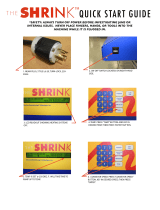
3
MIDDLEBY MARSHALL INC.
OVEN LIMITED WARRANTY
(Non U.S.A.)
The Seller warrants equipment manufactured by it to be free from
defects in material and workmanship for which it is responsible. The
Seller’s obligation under this warranty shall be limited to replacing
or repairing, at Seller’s option, without charge, F.O.B. Seller’s
factory, any part found to be defective and any labor and material
expense incurred by Seller in repairing or replacing such part. Such
warranty is limited to a period of one year from date of original
installation or 15 months from date of shipment from Seller’s factory,
whichever is earlier, provided that terms of payment have been fully
met. All labor shall be performed during regular working hours.
Overtime premium will be charged to the Buyer.
This warranty is not valid unless equipment is installed,
started, and demonstrated under the supervision of a fac-
tory-authorized installer.
Normal maintenance functions, including lubrication, adjustment of
airflow, thermostats, door mechanisms, microswitches, burners
and pilot burners, and replacement of light bulbs, fuses and
indicating lights, are not covered by warranty.
Any repairs or replacements of defective parts shall be performed
by Seller’s authorized service personnel. Seller shall not be
responsible for any costs incurred if the work is performed by other
than Seller’s authorized service personnel.
When returning any part under warranty, the part must be intact and
complete, without evidence of misuse or abuse, freight prepaid.
Seller shall not be liable for consequential damages of any kind
which occur during the course of installation of equipment, or which
result from the use or misuse by Buyer, its employees or others of
the equipment supplied hereunder, and Buyer’s sole and exclusive
remedy against Seller for any breach of the foregoing warranty or
otherwise shall be for the repair or replacement of the equipment
or parts thereof affected by such breach.
The foregoing warranty shall be valid and binding upon Seller if and
only if Buyer loads, operates and maintains the equipment supplied
hereunder in accordance with the instruction manual provided to
Buyer. Seller does not guarantee the process of manufacture by
Buyer or the quality of product to be produced by the equipment
supplied hereunder and Seller shall not be liable for any prospective
or lost profits of Buyer.
THE FOREGOING WARRANTY IS EXCLUSIVE AND IN LIEU OF
ALL OTHER EXPRESS AND IMPLIED WARRANTIES WHATSO-
EVER. SPECIFICALLY THERE ARE NO IMPLIED WARRANTIES
OF MERCHANTABILITY OR OF FITNESS FOR A PARTICULAR
PURPOSE.
The foregoing shall be Seller’s sole and exclusive obligation and
Buyer’s sole and exclusive remedy for any action, whether in
breach of contract or negligence. In no event shall seller be liable
for a sum in excess of the purchase price of the item.
Model No.
Modéle No.
Serial No.
Serié No.
Installation Date
Date d'installation
MIDDLEBY MARSHALL
NO QUIBBLE LIMITED WARRANTY
(U.S.A. ONLY)
MIDDLEBY MARSHALL, HEREINAFTER REFERRED TO AS
“THE SELLER”, WARRANTS EQUIPMENT MANUFACTURED
BY IT TO BE FREE FROM DEFECTS IN MATERIAL AND
WORKMANSHIP FOR WHICH IT IS RESPONSIBLE. THE
SELLER’S OBLIGATION UNDER THIS WARRANTY SHALL
BE LIMITED TO REPLACING OR REPAIRING, AT SELLER’S
OPTION, WITHOUT CHARGE, ANY PART FOUND TO BE
DEFECTIVE AND ANY LABOR AND MATERIAL EXPENSE
INCURRED BY SELLER IN REPAIRING OR REPLACING
SUCH PART. SUCH WARRANTY SHALL BE LIMITED TO
THE ORIGINAL PURCHASER ONLY AND SHALL BE EFFEC-
TIVE FOR A PERIOD OF ONE YEAR FROM DATE OF ORIGI-
NAL INSTALLATION, OR 18 MONTHS FROM DATE OF PUR-
CHASE, WHICHEVER IS EARLIER, PROVIDED THAT TERMS
OF PAYMENT HAVE BEEN FULLY MET.
This warranty is valid only if the equipment is installed, started,
and demonstrated under the supervision of a factory-autho-
rized installer.
Normal maintenance functions, including lubrication, cleaning,
or customer abuse, are not covered by this
no quibble war-
ranty
.
Seller shall be responsible only for repairs or replacements of
defective parts performed by Seller’s authorized service per-
sonnel. Authorized service agencies are located in principal
cities throughout the contiguous United States, Alaska, and
Hawaii. This warranty is valid in the 50 United States and is void
elsewhere unless the product is purchased through Middleby
International with warranty included.
The foregoing warranty is exclusive and in lieu of all other
warranties, expressed or implied. There are no implied
warranties of merchantability or of fitness for a particular
purpose.
The foregoing shall be Seller’s sole and exclusive obligation
and Buyer’s sole and exclusive remedy for any action, includ-
ing breach of contract or negligence. In no event shall Seller be
liable for a sum in excess of the purchase price of the item.
Seller shall not be liable for any prospective or lost profits of
Buyer.
This warranty is effective on Middleby Marshall equip-
ment sold on, or after, February 15, 1995.
© 2003 - Middleby Marshall, A Middleby Company.
The Middleby Marshall logo is a registered trademark of Middleby Marshall, A Middleby Company.
Middleby Marshall Inc. • 1400 Toastmaster Drive • Elgin, Illinois 60120-9272 U.S.A. • (847) 741-3300 • FAX: (847) 741 4406





















